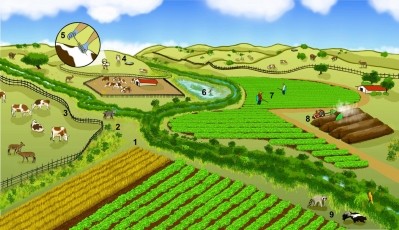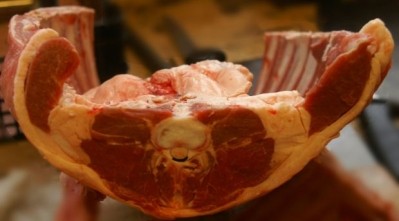E.coli buffer zone guidelines ‘could be inadequate’

Results suggest that risk for airborne transport is increased when feedlot pen surfaces are very dry and dusty, and when combined with cattle movement that generates airborne dust.
Current buffer zone guidelines are 120 meters [400 feet] from a feedlot, said the study in Applied and Environmental Microbiology.
It said the high percentages of leafy greens contaminated with E. coli suggest great risk for planting fresh produce 180m [590 feet] or less from a feedlot.
Leafy greens and planting distances
Spinach, turnip greens, and mustard greens were planted in plots located 60, 120, and 180 meters (200, 400, and 600 feet) from a cattle feedlot.
E. coli O157:H7 was found in leafy greens planted at all plot distances but contamination decreased as distance from the feedlot was increased.
The pathogen was recovered from 3.5% of leafy green samples per plot at 60 meters, which was higher (P < 0.05) than the 1.8% of positive samples per plot at 180 meters.
There is a critical need to determine safe set-back distances between fresh produce crops and cattle production that will reduce the risk for produce contamination, said the researchers.
In each of two years, leafy greens were planted to nine plots located 60, 120, and 180 meters from a cattle feedlot (3 plots each distance).
Leafy greens, feedlot manure, and bioaerosol samples were collected from June to September.
They sampled the feedlot surface manure in 10 feedlot pens, finding the pathogen in an average of 71.7 to 73.3% of samples in 2012 and 2011.
Comprehensive long term study
Elaine D. Berry, of the US Department of Agriculture, Agricultural Research Service, US Meat Animal Research Center, in Nebraska, said a variety of conditions can affect the level of contamination.
Following a period of high cattle management activity when the feedlot was dry and dusty, including removal of around 300 head of cattle for shipping, the rate of total non-pathogenic E. coli-contaminated samples per plot at 180 meters shot up to 92.2%.
However, total E. coli-positive leafy green samples were lower on one August sample date than any other, a finding the investigators attribute to cleaning and removal of feedlot surface manure from nearby pens a few weeks earlier.
Although E. coli O157:H7 was not recovered from air samples at any distance, total E. coli was recovered at the feedlot edge and all plot distances, indicating that airborne transport can occur.
Researchers acknowledged it was only in one state, which is not a produce growing place, but said it was a reasonable model for the produce growing regions.
Additional research is needed to know the safe set-back distances between cattle feedlots and crop production to reduce fresh produce contamination, said the study.
Source: Applied and Environmental Microbiology
Online ahead of print, DOI: 10.1128/AEM.02998-14
"Effect of Proximity to a Cattle Feedlot on Escherichia coli O157:H7 Contamination of Leafy Greens and Evaluation of the Potential for Airborne Transmission”
Authors: Elaine D. Berry, James E. Wells, James L. Bono, Bryan L. Woodbury, Norasak Kalchayanand, Keri N. Norman, Trevor V. Suslow, Gabriela López-Velasco and Patricia D. Millner








